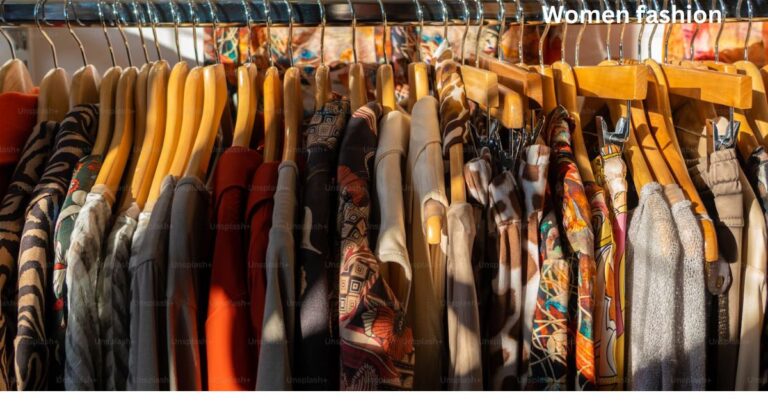Introduction
Women fashion is more than garb; it is an effective form of self-expression that evolves with society. From historical drapes to present-day couture, the narrative of girls’s fashion reflects cultural shifts, non-public identities, and converting developments. Fashion mirrors the social dynamics and character options of each generation. It tells the tale of a girl’s personality, her surroundings, and the world around her. Through creative writing, this article explores the evolution of ladies’s style, the influences shaping it, and how it embodies empowerment and identification.
The Historical Evolution of Women’s Fashion
For centuries, Women fashion style has passed through amazing modifications that reveal societal changes. In historic civilizations, girls’s clothing become useful, generally designed for modesty and practicality. However, as societies developed, so did fashion. The Renaissance introduced ornate, lavish attire with problematic information, symbolizing popularity and wealth. During the Victorian generation, girls’s style became structured, with corsets and long skirts representing femininity and discretion.
In the early 20th century, fashion took an intensive turn as girls’s roles in society shifted. The flapper style of the Nineteen Twenties, with its loose dresses and bold cuts, contemplated the newfound freedom and liberation girls have been experiencing. It was a revolt towards inflexible norms, signaling independence and social development. As the decades passed, every era saw new trends, from the glamorous Fifties dresses to the rebellious Nineteen Sixties miniskirts, all embodying the zeitgeist of the time.
The Influence of Culture and Media on Women’s Fashion
Culture has usually had a large affect on Women fashion shaping trends and styles across generations. Uniquely, media has played a pivotal position in disseminating style developments globally. During the 20th century, Hollywood icons like Marilyn Monroe, Audrey Hepburn, and Grace Kelly became the faces of style. Their style picks set trends that hundreds of thousands of ladies accompanied, solidifying the connection among popular culture and fashion.
In addition, style magazines, advertisements, and now social media have grown to be motors for placing developments and influencing tastes. With the rise of fashion bloggers and Instagram influencers, the media’s impact on fashion has only improved. Celebrities continue to set the tone for what’s taken into consideration stylish, often becoming synonymous with the manufacturers they wear. As cultural references shift and media evolve, fashion adapts, constantly reflecting the cutting-edge mood and possibilities of society.
Fashion as a Medium for Empowerment and Identity
In these days’s global, style is an awful lot greater than just a classy preference. It is a medium for self-expression, empowerment, and identification formation. Women’s style permits individuals to talk who they’re without pronouncing a word. Through garb selections, girls can explicit their personalities, values, or even political affairs.
For instance, the upward thrust of sustainable style displays a developing focus of environmental duty. Many ladies are choosing brands that align with their ethical values, emphasizing the strength of aware consumerism. Similarly, the trend towards gender-impartial apparel breaks down conventional gender norms, allowing girls to dress in a way that feels true to themselves.
Fashion also plays an important function in empowering women, presenting them with the confidence to stand out and be themselves. A well-tailored dress or a bold get-dress could make an effective assertion, giving women the braveness to embrace their strength and independence. In this way, style isn’t just about look but also approximately fostering self-belief and individuality.
The Role of Technology in Shaping Modern Women’s Fashion
With improvements in era, the style industry has entered an era of speedy innovation. Online purchasing has revolutionized how ladies get right of entry to and purchase garb, making fashion more accessible than ever earlier. Additionally, technologies like digital truth (VR) and synthetic intelligence (AI) are reworking the way ladies revel in style. AI-generated fashion tips cater to individual tastes, even as VR allows for digital style shows and strive-ons.
Moreover, social media systems which includes Instagram, Pinterest, and TikTok, have emerged as style hubs in which trends emerge and evolve hastily. Fashion influencers use these structures to exhibit their non-public patterns and collaborate with manufacturers, permitting ladies global to find out new trends right away. The integration of generation into fashion is accelerating creativity, enabling girls to discover limitless possibilities of their cloth cabinet alternatives.
Sustainability and the Future of Women’s Fashion
One of the most essential troubles going through women’s fashion nowadays is sustainability. With rapid style dominating the enterprise, worries about environmental effect have risen. Many customers at the moment are turning to sustainable-style brands that prioritize eco-friendly materials and ethical production procedures. This shift marks a sizeable motion closer to aware consumerism and mindful fashion selections.
Moreover, gradual style advocates are encouraging girls to invest in amazing, timeless pieces in place of following fleeting traits. This approach no longer best reduces waste but additionally emphasizes the value of craftsmanship and toughness in apparel. As the style enterprise continues to conform, sustainability is predicted to play a larger role, with designers and consumers alike focusing on reducing the enterprise’s environmental footprint.
The Personalization and Inclusivity Revolution in Fashion
Inclusivity has grown to be a defining feature of current ladies’s fashion. Designers and brands are spotting the importance of catering to diverse body sorts, skin tones, and personal alternatives. This shift is making fashion extra accessible to girls of all shapes, sizes, and backgrounds. Plus-length styles, adaptive garb for individuals with disabilities, and gender-inclusive collections are breaking boundaries, permitting every girl to find styles that make her sense assured and empowered.
Moreover, personalization has emerged as a key trend in ladies’s fashion. Many manufacturers now provide custom tailoring, allowing women to create garments that fit their precise frame styles and sizes. Personalization extends to fashion choices as well, with customizable options in the whole lot, from shoes to handbags. This revolution is redefining fashion as a deeply non-public and inclusive experience, celebrating the uniqueness of every person.
Conclusion
Women fashion has advanced through centuries, continuously reflecting the changing roles, values, and aspirations of women in society. From ancient robes symbolizing fame to modern styles embodying empowerment and individuality, fashion tells an effective tale. Today, fashion is more than simply apparel—it is a form of self-expression, a tool for empowerment, and a reflection of private identity. As the era advances and sustainability becomes more outstanding, the destiny of ladies’s fashion will continue to evolve. Through style, girls will preserve shaping the arena around them—the use of fashion as a voice for who they’re and what they stand for.

